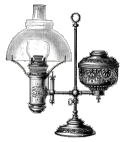In addition to chimneys, shades and globes, Macbeth-Evans manufactured lighthouse [fresnel] lenses, glass for marine, railroad and later, automotive use, and laboratory glassware. It introduced its first water set in the mid 1920's and the colored glassware era began. The first complete colored line was produced in 1930 and many others quickly followed. Popular patterns were: Dogwood, Thistle, Petalware and American Sweetheart. In 1937 the company was bought by Corning Glass Works of New York, but operation continued under Macbeth-Evans until the late 1940's.4  George A. Macbeth & Thomas Evans' Patents George A. Macbeth & Thomas Evans' Patents
To view any of the above patents, enter the number in the box below and select Query USPTO Database. This will take you to the specific patent images on the U.S. Patent & Trademark Office Database. Learn more about the USPTO here. End Notes
References
|

| Reference Desk | Lamp Information | Other Resources | On-Line Shopping |

Purveyors of Antique Lighting and Accessories
435 Main Street
 Hurleyville, New York 12747
Hurleyville, New York 12747
|
produced by Macbeth-Evans |
|
Keystone Iron Clad Superior Crescent Empire |
|
|
|
Pearl Glass |
a brief historical profile of

Macbeth-Evans Glass Company
^ Top of Page
Privacy Policy | Terms and Conditions of Use | Announcements
Copyright © 2001-2011 ~ Daniel Edminster | The Lampworks ~ All Rights Reserved


